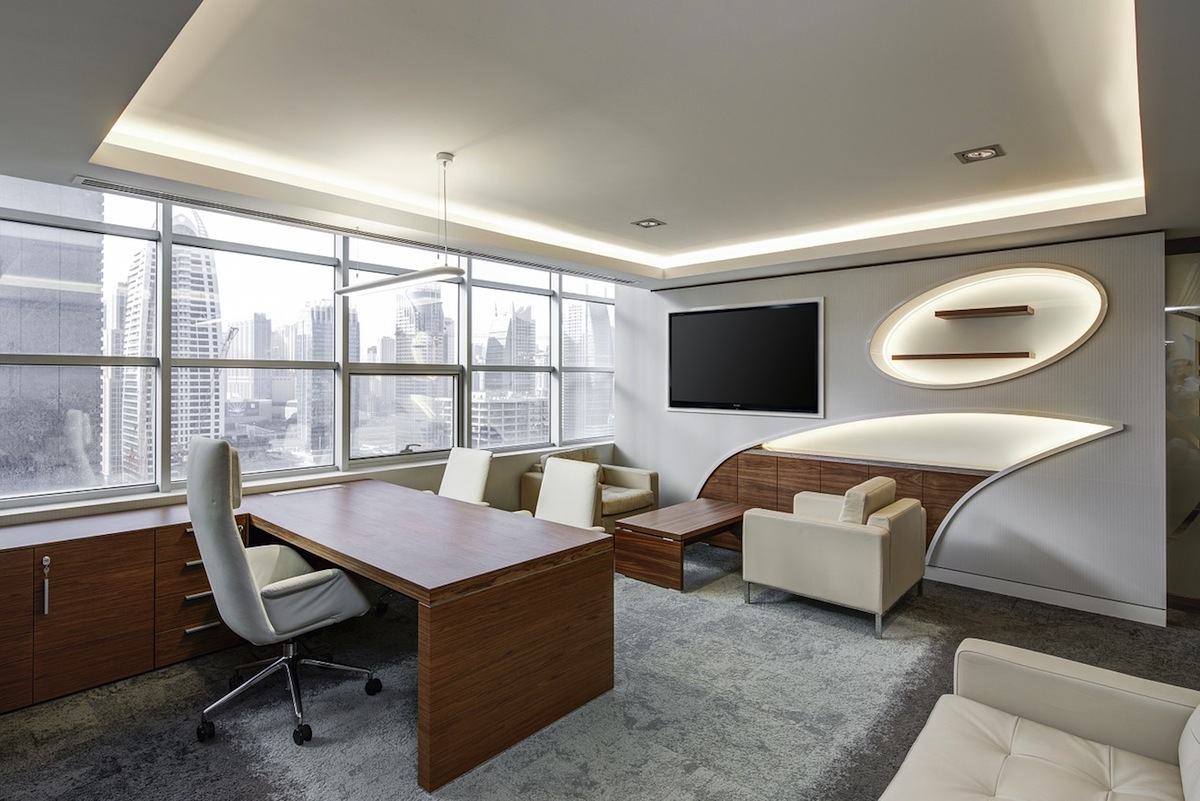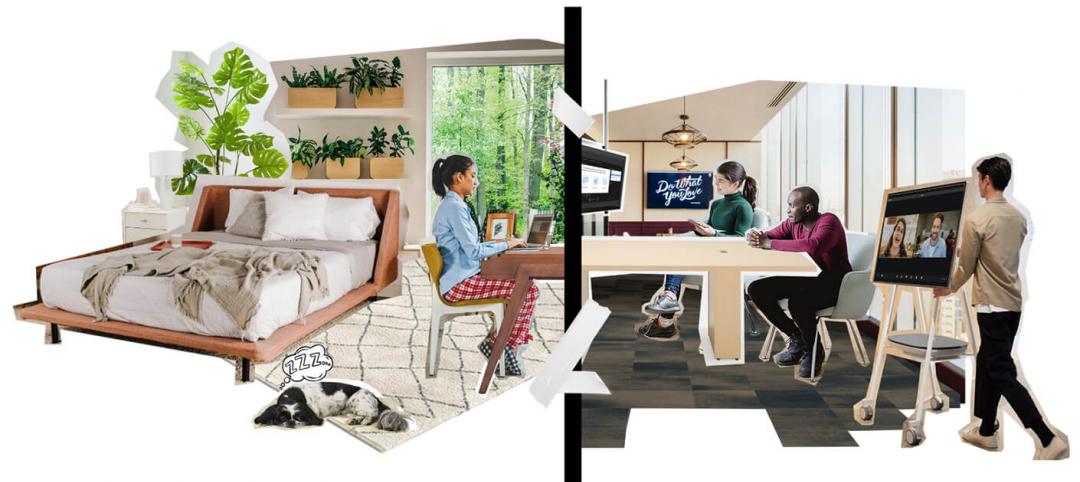It’s tempting to generalize workplaces in the tech sector as amenity-rich, open-plan spaces filled with Millennials collaborating. Although there are plenty of workplaces that support this generalization, tech workplaces offer numerous lessons that can benefit other sectors.
Beyond space and programmatic considerations, four tenets highlight today’s tech workplaces: strength of story, design empathy, technology presence, and hackerspace.
1. Strength of story = quality of experience
Purposeful connection to a memorable workplace can no longer be quantified by offering perks through amenities. The experience of first impression, a surprise/”wow” factor, and how the story unfolds with meaningful spaces are ultimately the lasting experience that differentiate a place where people want to thrive from a typical workplace. This goes beyond the company’s brand, and is of utmost importance given the strong market pressures on recruitment and retention. We ask WHAT stories a company wants to share, whether it’s for new recruits, clients/customers, partners, colleagues, or even friends and family. Spaces need to be designed to be interwoven with these stories.
Every company has examples. There’s always lore about how the company is founded, defined or strengthened. From the founders coming from Wall Street to Main Street with a cause, or an idea budding out of helping others, or a team retreat at the zoo, or a night of bar-hopping ending with a mutual phrase and bond, these stories are passed down from each generation of staff. Often times these stories are told through casual tours, and broadcasted through social networks. A quick tweet or Instagram announcement leads to even broader exchanges that feed into the pride and uniqueness of place. These authentic stories connect us and inform the cultural pulse and soul of the inhabited space.
2. Design empathy – building a meaningful experience of place counts
We hear more and more from tech companies that employees are seeking positions that go beyond compensation and benefits. Alignment of core values and purpose between the individual and the company are paramount given the increasingly blurred line between our personal and professional selves. With clients seeking designs that are empathetic to their staff, we’re seeing more personalized workplaces that go beyond functionality and efficiency. Best practices include:
• Focus on basic convenience needs like access to electrical power wherever you need it – not when.
• Design for the senses by enhancing lighting, aroma, and audio. This includes introducing lighting conditions that are space-specific, controllable, and that contribute to character of space.
• Introduce non-invasive creative breaks, such as visual interest features at various distances that allow eyes to look away from screen, relax, and re-focus.
• Appropriately scaled places to stretch out so the body is not locked and stationary.
• Pet-friendly environment that encourages social interaction and stress relief.
• Calming areas for recharge such as nap rooms, meditation rooms, and outdoor space, as well as services like massage programs.
• Creating spaces that go beyond work activities and are inclusive of flexible social uses. This can include spaces for both large industry events and intimate team gatherings, or individual sanctuaries that allow a person to escape the assigned workstation. These multi-functional spaces are fluid and programmed to adapt with changing needs throughout a given day.
3. Technology omnipresence
Individual mobility has now been established and well defined in this sector. Laptops and smartphones are default tools, so certain work functions and interaction can ideally be anywhere and anytime. Within the workplace, the drive now is for the environment to be automated, to understand individual and group needs, whether for a presentation, training, or collaboration.
This is an extension of the Internet of Things, where data can be collected to improve and anticipate future needs. Think the Quantified Self – but for workplace. For now this is most relevant to facility and workplace planners, where having solid data to right-size the environment directly saves cost on maintenance and construction.
The next step is for the same data set to influence the flexibility of space and environment. For instance, understanding the best design solutions to address inherent conflicts in an open office – the introvert/extrovert dialog, visual/acoustical disruptions, tailoring the plethora of collaboration solutions to fit the users, and finding adaptable methods within construction and furniture solutions that define workspace. Though this trend is more commonplace in the tech industry, it is making its way into all workplaces as companies seek to better inform their decisions about space.
4. Hackerspace
The pressure of tech spaces to perform and evolve parallels the speed of change in the tech sector. Shorter leases and subleases are frequently signed to address the low vacancy rate in a booming market, the unpredictability of growth, and the uncertainty of the business model. Three-year leases or subleases from past tenants that have outgrown the space are common.
We see an increase in designing spaces with the expectation they will change within a year or two of moving in. In most cases, it’s not a symptom of poor planning, but rather, the speed gap between the tech evolution versus our own design, manufacturing and construction industry. Decisions made eight months ago during programming and design may not be applicable at first day of business.
With these pressure points, the need for spaces to be inherently hackable are both desired and often required—and with the pace of business speeding up in all industries, this situation isn’t relegated to the tech world. How can design adapt and be customized to an individual, group, or organization’s needs? And address it in a way that’s fast, invisible and intuitive? These ephemeral parameters lead to solutions that are hacked from multiple disparate resources, such as residential retailers, bespoke shops, and local makers.
So what’s next?
We are frequently asked to forecast and pick a handful of trends as prescriptive solutions. Often these prescriptions discount design value and objectify design to commodities that can be bought off the shelf. We see companies associated with the tech sector trying to do this. For instance, furniture manufacturers are strategically changing their marketing from products supporting work functions (i.e. workstations and collaboration solutions) to inclusive built environments that support individual and group dynamics (i.e. designs addressing introvert/extrovert). The increased emphasis on ancillary furniture are examples of this, too; it’s an extension of creating workplaces that evoke home and hospitality.
That the tech sector catalyzes workplace trends is a testament to its anthropologic tendency to create responsive, empathetic designs. Because of the multiple convergences of culture and demographics, coupled by the speed of evolution and risky business model of constantly seeking out unrealized solutions, design solutions cannot be quantified. Our design solutions are increasingly qualitative – calling on our creative talents to understand our clients beyond their brand, and adapting our processes to create an environment that offers them purpose and value.
About the Author: Hakee Chang is a Senior Designer in Perkins+Will's San Francisco office, focusing on workplace design. With more than 17 years of experience, he has covered numerous project types, from bio-pharmaceuticals to apparel to technology. His designs focus on creating unique experiences that engage, connect, and move brands and organizations forward.
More from Author
Perkins and Will | Sep 19, 2023
Transforming shopping malls into 21st century neighborhoods
As we reimagine the antiquated shopping mall, Marc Asnis, AICP, Associate, Perkins&Will, details four first steps to consider.
Perkins and Will | Jul 20, 2023
The co-worker as the new office amenity
Incentivizing, rather than mandating the return to the office, is the key to bringing back happy employees that want to work from the office. Spaces that are designed and curated for human-centric experiences will attract employees back into the workplace, and in turn, make office buildings thrive once again. Perkins&Will’s Wyatt Frantom offers a macro to micro view of the office market and the impact of employees on the future of work.
Perkins and Will | May 30, 2023
How design supports a more holistic approach to training
For today’s college athletes, training is no longer about cramming team practices and weight lifting sessions in between classes.
Perkins and Will | Dec 20, 2022
4 triage design innovations for shorter wait times
Perkins and Will shares a nurse's insights on triage design, and how to help emergency departments make the most of their resources.
Perkins and Will | Aug 30, 2021
The great re-shuffle & re-think
In this new hybrid environment in which we cater to how our employees work best, how will we manage new hybrid work practices and etiquette?
Perkins and Will | May 18, 2020
Global design firms collaborate on new COVID-19 mobile testing lab to bring testing to vulnerable communities worldwide
Perkins and Will, Schmidt Hammer Lassen Architects, and Arup Group develop scalable solutions for increased testing capacity within high-density and under-served neighborhoods.
Perkins and Will | Jun 7, 2019
Workplace wellness: Top 3 tips for Fitwel certification
How can thoughtful design encourage healthier choices, lifestyles, and work environments?
Perkins and Will | Feb 27, 2019
ResilientSEE: A framework to achieve resilience across scales
Conceived in the Boston studio of Perkins+Will, the ResilientSEE team developed a resilient planning framework that can be applied to other neighborhoods, cities, and countries.
Perkins and Will | Nov 28, 2018
Amazon HQ2 and the new geography of work
The big HQ2 takeaway is how geography and mobility are becoming major workplace drivers.
Perkins and Will | Sep 4, 2018
It takes more than money to fund resilience
Resilient design, much like all projects in the built environment, requires funding.
















